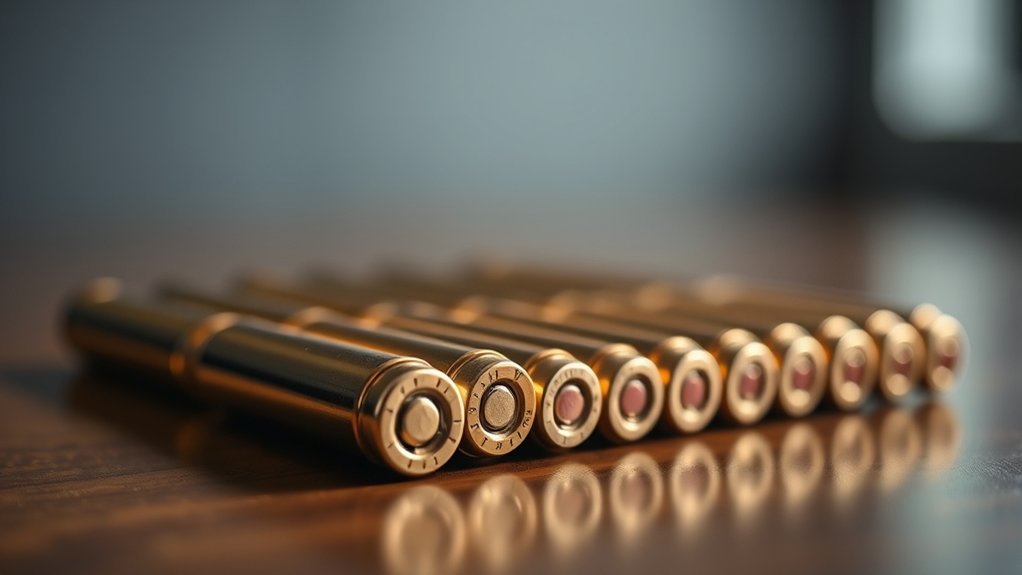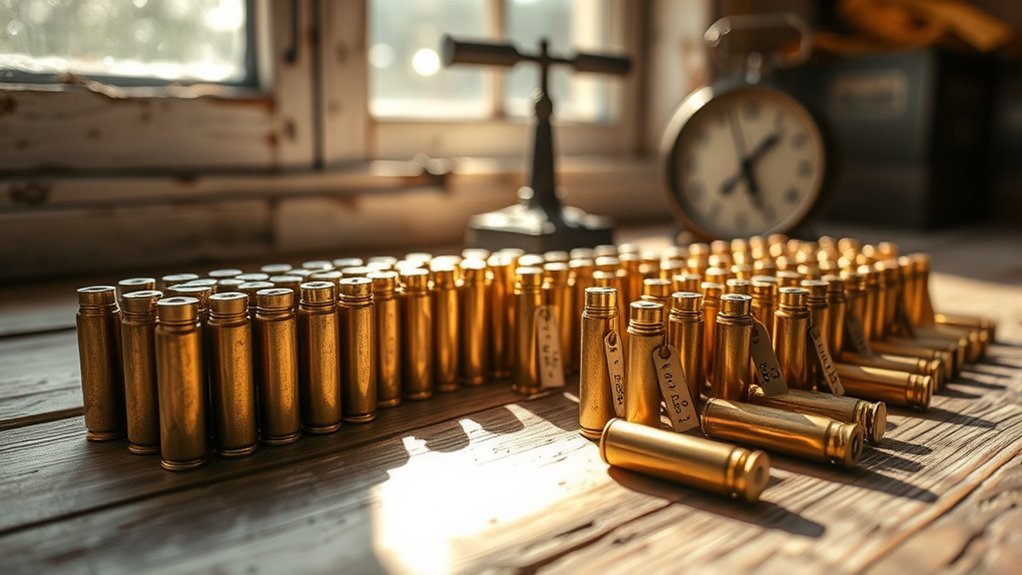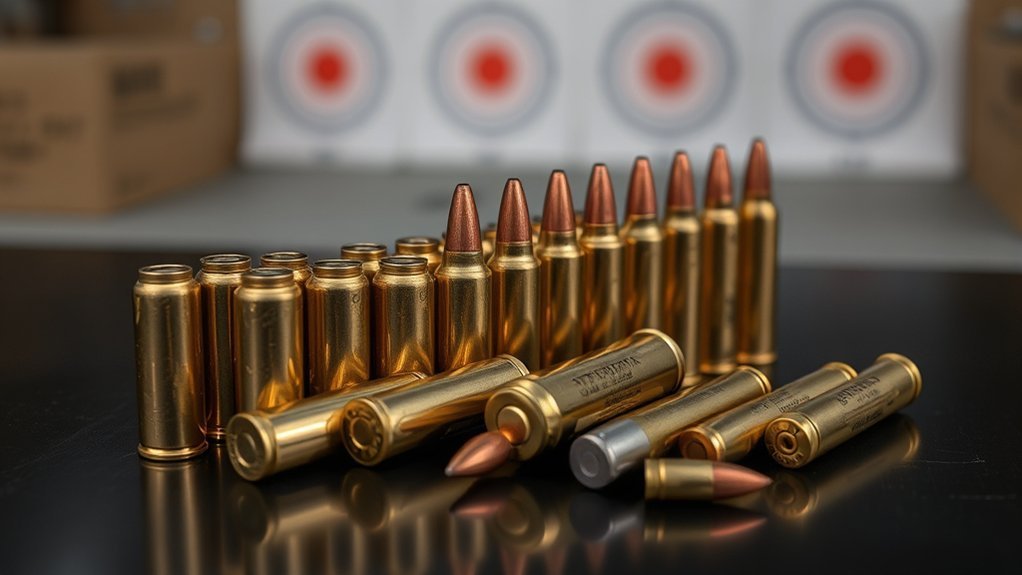When it comes to ammunition, the term “grain” refers to the weight of the bullet, a critical factor in its performance. Understanding grain is essential for selecting the right ammunition for your specific needs. It influences various aspects like velocity and recoil, which can affect your shooting experience. So, how do you determine the best grain for your firearm? Let’s explore the nuances of this measurement and its implications in more detail.
Understanding the Concept of Grain

Grain, in the context of ammunition, refers to the weight of a bullet, typically measured in grains (gr). This measurement helps you understand the bullet’s ballistic performance and suitability for specific applications. A grain equals 1/7000th of a pound, meaning a 180-grain bullet weighs approximately 0.0257 pounds. The bullet’s weight influences its velocity, energy, and trajectory. Lighter bullets generally achieve higher speeds but may lack energy at longer distances, while heavier bullets offer better penetration and stability. Understanding grain allows you to compare different ammunition types, ensuring you select the right bullet for your needs, whether for target shooting, hunting, or self-defense. Therefore, grain is an essential factor in ammunition selection and performance.
The History of Grain as a Measurement

Understanding the history of grain as a measurement reveals its origins in various measurement systems. You’ll see how it shifted into modern usage, particularly in ammunition, and its significant impact on ballistics performance. This context is essential for grasping why grain remains a standard unit today.
Origins of Measurement Systems
While many modern measurement systems rely on standardized units, the term “grain” has its roots in ancient practices, reflecting a time when weight was determined by the mass of small seeds. Originating from the Latin word “granum,” which means seed or grain, this measurement system was widely used by early civilizations. Merchants and traders utilized grains as a reference point for weighing precious commodities. For this reason, one grain was defined as the weight of a single barleycorn. Over time, the grain became a standard unit for measuring small weights, particularly in the field of ammunition. Its historical significance underscores the evolution of measurement, illustrating how practical needs shaped our understanding of weight and quantity.
Transition to Modern Usage
As the demand for precision in ammunition grew, the grain measurement shifted from its ancient roots to a standardized format that modern shooters and manufacturers rely on today. This change has streamlined the way you understand bullet weights and performance. Key developments in this evolution include:
- Standardization: Establishing a consistent grain measurement system across various ammunition types.
- Precision: Allowing for more accurate loading specifications, enhancing reliability and performance.
- Compatibility: Ensuring that different manufacturers’ products can be compared directly based on grain weight.
- Education: Helping shooters of all skill levels better understand the importance of grain in selecting their ammunition.
This standardized approach to grain has become essential for anyone serious about ammunition performance.
Impact on Ballistics Performance
The grain measurement directly influences ballistics performance, affecting everything from trajectory to terminal ballistics. When you choose ammunition, the grain weight of a bullet determines how it behaves in flight. Lighter bullets, typically under 100 grains, often achieve higher velocities, resulting in flatter trajectories. However, they may sacrifice penetration and energy transfer upon impact. Conversely, heavier bullets, generally over 150 grains, tend to offer better stability and greater terminal performance, making them ideal for hunting and self-defense scenarios. Understanding these dynamics helps you make informed choices for specific shooting applications. Ultimately, the grain is not just a number; it’s a critical factor that shapes your shooting experience and effectiveness in various situations.
How Grain Affects Bullet Performance

Understanding how grain affects bullet performance is essential for anyone looking to optimize their shooting experience. The grain weight directly influences various factors, including:
- Trajectory: Heavier bullets typically maintain a flatter trajectory, enhancing long-range accuracy.
- Recoil: Lighter bullets generate less recoil, making them easier to handle, especially for novice shooters.
- Terminal Ballistics: Heavier projectiles often deliver more energy upon impact, which can improve stopping power.
- Wind Drift: Heavier bullets are less susceptible to wind drift, enhancing stability in windy conditions.
The Relationship Between Grain and Velocity
When selecting ammunition, understanding the relationship between grain and velocity is essential. Heavier bullets, measured in grains, typically generate lower velocities due to increased mass, while lighter bullets achieve higher speeds. Finding the ideal grain for your specific needs can optimize both performance and accuracy.
Bullet Weight Impact
Bullet weight, measured in grains, plays an essential role in determining a projectile’s velocity and overall performance. Understanding how weight impacts various factors can help you choose the right ammunition for your needs:
- Momentum: Heavier bullets deliver more momentum, aiding penetration.
- Trajectory: Lighter bullets typically have a flatter trajectory, improving accuracy over distance.
- Recoil: Increased bullet weight often results in greater recoil, affecting shootability.
- Terminal Ballistics: Heavier projectiles can create larger wound channels, enhancing stopping power.
Choosing the right bullet weight for your intended application is vital, as it directly influences these performance characteristics. By considering these factors, you’ll make more informed decisions about your ammunition choices.
Speed vs. Grain
The relationship between grain weight and velocity is a key consideration in ammunition performance. Generally, lighter bullets (lower grain) travel faster than heavier ones. This speed can affect trajectory, energy transfer, and penetration. Understanding this relationship helps you make informed choices based on your shooting needs.
| Bullet Weight (Grain) | Velocity (FPS) |
|---|---|
| 55 | 3,200 |
| 62 | 2,900 |
| 77 | 2,600 |
As you can see, as the grain weight increases, the velocity typically decreases. This trade-off is vital—higher velocity can enhance accuracy and reduce drop, while heavier grains may improve terminal ballistics. Balancing these factors is essential for optimizing your ammunition selection.
Ideal Grain Selection
Selecting the ideal grain for your ammunition involves understanding how it influences both performance and intended use. The grain weight directly affects velocity, accuracy, and terminal performance. Here are key factors to examine when choosing grain:
- Purpose: Determine if you’re using the ammunition for target shooting, self-defense, or hunting.
- Barrel Length: Longer barrels typically benefit from heavier grains due to increased stability and velocity.
- Caliber Compatibility: Different calibers respond uniquely to grain weight; consult manufacturer recommendations for best performance.
- Environmental Conditions: Wind and elevation can affect how grain weight performs, influencing your choice for specific situations.
Choosing the Right Grain for Your Firearm
When you’re choosing the right grain for your firearm, understanding how bullet weight affects performance is vital. Heavier bullets typically provide better penetration and energy retention, making them suitable for hunting or self-defense. Conversely, lighter bullets often achieve higher velocities, resulting in flatter trajectories and reduced recoil, which can enhance accuracy for competitive shooting or target practice.
You’ll also want to take into account the specific purpose of your shooting. For tactical applications, a balance between weight and velocity might be critical, while varmint hunting may benefit from lighter, faster rounds. Always consult your firearm’s manufacturer recommendations and test different grain weights to identify what works best for your needs, ensuring peak performance and safety in every shot.
Common Grain Weights in Popular Calibers
Several common grain weights are associated with popular calibers, each offering distinct performance characteristics suited for various shooting applications. Understanding these weights can help you select the right ammunition for your needs. Here are some typical grain weights for well-known calibers:
Common grain weights for popular calibers influence performance, aiding in selecting the right ammunition for specific shooting needs.
- .22 LR: 30-40 grains, ideal for small game and target shooting.
- 9mm: 115-147 grains, balancing recoil and stopping power for self-defense.
- .223 Remington: 55-77 grains, versatile for varmint hunting and tactical use.
- .308 Winchester: 150-180 grains, suitable for hunting and long-range shooting.
The Impact of Grain on Recoil
Grain weight significantly influences recoil, which directly affects your shooting experience and performance. Heavier projectiles, measured in grains, typically generate more recoil due to increased momentum upon firing. If you choose ammunition with a higher grain weight, you’ll likely feel a stronger push against your shoulder, which can lead to fatigue over extended shooting sessions. Conversely, lighter grains produce less recoil, enabling quicker follow-up shots and more manageable handling. This is particularly beneficial in competitive shooting or when practicing for accuracy. Understanding the relationship between grain weight and recoil allows you to select ammunition that aligns with your shooting style and comfort level, ensuring a more effective and enjoyable shooting experience overall.
Grain and Its Role in Accuracy
Ammunition grain weight plays a crucial role in determining accuracy at various distances. The grain affects how a bullet behaves in flight and impacts your shooting performance. Here are key aspects to evaluate:
- Ballistic Coefficient: Heavier grains often have a higher ballistic coefficient, improving stability and reducing wind drift.
- Velocity: Lighter grains typically achieve higher velocities, which can enhance initial accuracy but may suffer at longer ranges.
- Trajectory: Grain weight influences bullet drop; heavier bullets maintain energy better, providing a flatter trajectory.
- Barrel Twist Rate: Different grain weights can require specific twist rates in your rifle’s barrel for ideal stabilization.
Understanding these dynamics can appreciably enhance your shooting precision and effectiveness in the field.
Tips for Selecting Ammunition by Grain
When selecting ammunition, it’s essential to contemplate how grain weight aligns with your specific shooting needs and conditions. For target shooting, lighter grains (e.g., 115-124 grains for 9mm) can enhance speed and accuracy, while heavier grains (e.g., 147 grains) may offer better stability and energy transfer. For hunting, consider the game size; lighter bullets work well for small game, while heavier options are more effective for larger animals. Additionally, consider the shooting distance; heavier rounds generally perform better at longer ranges due to their ballistic advantages. Finally, test various grain weights in your firearm to determine what provides the best performance and reliability. Always match the ammunition to your specific firearm’s capabilities and your intended application.
Conclusion
In the world of ammunition, grain acts like a compass guiding your shooting journey. Just as a sailor adjusts their sails to harness the wind, you must select the right grain to optimize performance for your firearm. Each grain weight influences velocity, energy, and recoil, shaping your experience on the range or in the field. By understanding grain, you become the captain of your shooting destiny, steering towards precision and accuracy with every shot fired.

